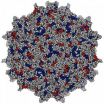(Press-News.org) CAMBRIDGE, MA -- Inspired by tiny particles that carry cholesterol through the body, MIT chemical engineers have designed nanoparticles that can deliver snippets of genetic material that turn off disease-causing genes.
This approach, known as RNA interference (RNAi), holds great promise for treating cancer and other diseases. However, delivering enough RNA to treat the diseased tissue, while avoiding side effects in the rest of the body, has proven difficult.
The new MIT particles, which encase short strands of RNA within a sphere of fatty molecules and proteins, silence target genes in the liver more efficiently than any previous delivery system, the researchers found in a study of mice.
"What we're excited about is how it only takes a very small amount of RNA to cause gene knockdown in the whole liver. The effect is specific to the liver — we get no effect in other tissues where you don't want it," says Daniel Anderson, the Samuel A. Goldblith Associate Professor of Chemical Engineering and a member of MIT's Koch Institute for Integrative Cancer Research.
Anderson is senior author of a paper describing the particles in the Proceedings of the National Academy of Sciences the week of Feb. 10. Robert Langer, the David H. Koch Institute Professor at MIT, is also an author.
The research team, which included scientists from Alnylam Pharmaceuticals, also found that the nanoparticles could powerfully silence genes in nonhuman primates. The technology has been licensed to a company for commercial development.
Natural inspiration
RNA interference is a naturally occurring phenomenon that scientists have been trying to exploit since its discovery in 1998. Snippets of RNA known as short interfering RNA (siRNA) turn off specific genes inside living cells by destroying the messenger RNA molecules that carry DNA's instructions to the rest of the cell.
Scientists hope this approach could offer new treatments for diseases caused by single mutations, such as Huntington's disease, or cancer, by blocking mutated genes that promote cancerous behavior. However, developing RNAi therapies has proven challenging because it is difficult to deliver large quantities of siRNA to the right location without causing side effects in other tissues or organs.
In previous studies, Anderson and Langer showed they could block multiple genes with small doses of siRNA by wrapping the RNA in fatlike molecules called lipidoids. In their latest work, the researchers set out to improve upon these particles, making them more efficient, more selective, and safer, says Yizhou Dong, a postdoc at the Koch Institute and lead author of the paper.
"We really wanted to develop materials for clinical use in the future," he says. "That's our ultimate goal for the material to achieve."
The design inspiration for the new particles came from the natural world — specifically, small particles known as lipoproteins, which transport cholesterol and other fatty molecules throughout the body.
Like lipoprotein nanoparticles, the MIT team's new lipopeptide particles are spheres whose outer membranes are composed of long chains with a fatty lipid tail that faces into the particle. In the new particles, the head of the chain, which faces outward, is an amino acid (the building blocks of proteins). Strands of siRNA are carried inside the sphere, surrounded by more lipopeptide molecules. Molecules of cholesterol embedded in the membrane and an outer coating of the polymer PEG help to stabilize the structure.
The researchers tuned the particles' chemical properties, which determine their behavior, by varying the amino acids included in the particles. There are 21 amino acids found in multicellular organisms; the researchers created about 60 lipopeptide particles, each containing a different amino acid linked with one of three chemical groups — an acrylate, an aldehyde, or an epoxide. These groups also contribute to the particles' behavior.
Targeted strike
The researchers then tested the particles' ability to shut off the gene for a blood clotting protein called Factor VII, which is produced in the liver by cells called hepatocytes. Measuring Factor VII levels in the bloodstream reveals how effective the siRNA silencing is.
In that initial screen, the most efficient particle contained the amino acid lysine linked to an epoxide, so the researchers created an additional 43 nanoparticles similar to that one, for further testing. The best of these compounds, known as cKK-E12, achieved gene silencing five times more efficiently than that achieved with any previous siRNA delivery vehicle.
In a separate experiment, the researchers delivered siRNA to block a tumor suppressor gene that is expressed in all body tissues. They found that siRNA delivery was very specific to the liver, which should minimize the risk of off-target side effects.
"That's important because we don't want the material to silence all the targets in the human body," Dong says. "If we want to treat patients with liver disease, we only want to silence targets in the liver, not other cell types."
In tests in nonhuman primates, the researchers found that the particles could effectively silence a gene called TTR (transthyretin), which has been implicated in diseases including senile systemic amyloidosis, familial amyloid polyneuropathy, and familial amyloid cardiomyopathy.
The MIT team is now trying to learn more about how the particles behave and what happens to them once they are injected, in hopes of further improving the particles' performance. They are also working on nanoparticles that target organs other than the liver, which is more challenging because the liver is a natural destination for foreign material filtered out of the blood.
INFORMATION:
The research was funded by Alnylam Pharmaceuticals and the National Institutes of Health.
Written by Anne Trafton, MIT News Office
Better RNA interference, inspired by nature
2014-02-11
ELSE PRESS RELEASES FROM THIS DATE:
University of Tennessee study finds crocodiles climb trees
2014-02-11
When most people envision crocodiles, they think of them waddling on the ground or wading in water—not climbing trees. However, a University of Tennessee, Knoxville, study has found that the reptiles can climb trees as far as the crowns.
Vladimir Dinets, a research assistant professor in the Department of Psychology, is the first to thoroughly study the tree-climbing and -basking behavior. The research is published in the journal Herpetology Notes and can be found at http://bit.ly/Myi8yr.
Dinets and his colleagues observed crocodile species on three continents—Australia, ...
Caltech-developed method for delivering HIV-fighting antibodies proven even more promising
2014-02-11
In 2011, biologists at the California Institute of Technology (Caltech) demonstrated a highly effective method for delivering HIV-fighting antibodies to mice—a treatment that protected the mice from infection by a laboratory strain of HIV delivered intravenously. Now the researchers, led by Nobel Laureate David Baltimore, have shown that the same procedure is just as effective against a strain of HIV found in the real world, even when transmitted across mucosal surfaces.
The findings, which appear in the February 9 advance online publication of the journal Nature Medicine, ...
The content of our cooperation, not the color of our skin
2014-02-11
It's widely acknowledged that a common threat unites people. Individuals who were previously separated by social class, race or ethnicity come together, forming new cooperative alliances to defeat a common enemy. But does it take an external threat — an attack like Pearl Harbor or 9/11 — to make these social divisions melt away?
A study by behavioral scientists at UC Santa Barbara demonstrates that peaceful cooperation has the same effect as intergroup conflict in erasing social boundaries connected to race. Their findings appear today in the journal PLOS ONE.
"Evolution ...
Fish living near the equator will not thrive in the warmer oceans of the future
2014-02-11
According to an international team of researchers, the rapid pace of climate change is threatening the future presence of fish near the equator.
"Our studies found that one species of fish could not even survive in water just three degrees Celsius warmer than what it lives in now," says the lead author of the study, Dr Jodie Rummer from the ARC Centre of Excellence for Coral Reef Studies (Coral CoE) at James Cook University.
Dr Rummer and her colleagues studied six common species of fish living on coral reefs near the equator. She says many species in this region only ...
How our brain networks: Research reveals white matter 'scaffold' of human brain
2014-02-11
For the first time, neuroscientists have systematically identified the white matter "scaffold" of the human brain, the critical communications network that supports brain function.
Their work, published Feb. 11 in the open-source journal Frontiers in Human Neuroscience, has major implications for understanding brain injury and disease. By detailing the connections that have the greatest influence over all other connections, the researchers offer not only a landmark first map of core white matter pathways, but also show which connections may be most vulnerable to damage.
"We ...
Scientists identify gene linking brain structure to intelligence
2014-02-11
For the first time, scientists at King's College London have identified a gene linking the thickness of the grey matter in the brain to intelligence. The study is published today in Molecular Psychiatry and may help scientists understand biological mechanisms behind some forms of intellectual impairment.
The researchers looked at the cerebral cortex, the outermost layer of the human brain. It is known as 'grey matter' and plays a key role in memory, attention, perceptual awareness, thought, language and consciousness. Previous studies have shown that the thickness of ...
New research sheds light on how the body regulates fundamental neuro-hormone
2014-02-11
New research has revealed a previously unknown mechanism in the body which regulates a hormone that is crucial for motivation, stress responses and control of blood pressure, pain and appetite. The breakthrough could be used to design drugs to help fight health problems connected with these functions in the future.
Researchers at the University of Bristol and University College London found that lactate – essentially lactic acid – causes cells in the brain to release more noradrenaline (norepinephrine in US English), a hormone and neurotransmitter which is fundamental ...
Researchers discover 'epic' new Burgess Shale site in Canada's Kootenay National Park
2014-02-11
February 11, 2014 Kootenay National Park, British Columbia -- Yoho National Park's 505-million-year-old Burgess Shale – home to some of the planet's earliest animals, including a very primitive human relative – is one of the world's most important fossil sites. Now, more than a century after its discovery, a compelling sequel has been unearthed: 42 kilometres away in Kootenay National Park, a new Burgess Shale fossil site has been located that appears to equal the importance of the original discovery, and may one day even surpass it.
The find was made in the summer of ...
Minority political candidates just need a chance
2014-02-11
EAST LANSING, Mich. — It's not necessarily voters who should be blamed for the lack of minorities in state legislatures, but instead the two major political parties for not recruiting enough candidates, indicates new research by a Michigan State University scholar.
Eric Gonzalez Juenke analyzed nearly 10,000 statehouse elections in 2000 and 2010 and found Latino candidates were on the ballot just 5 percent of the time. But when Latinos did run for office, they won just as often as their white counterparts – even in districts where most voters were white.
Juenke's other ...
Biodiversity in production forests can be improved without large costs
2014-02-11
Forest management is based on recommendations that are supposed to maximize economic revenues. However, in 40% of cases a better economic result would be achieved by neglecting some of the recommendations. This would also greatly benefit biodiversity.
These results were obtained by a research group lead by Professor Mikko Mönkkönen at the University Jyväskylä. The group studied a production forest landscape encompassing 68 square kilometers of land and more than 30,000 forest stands in Central Finland.
The research project aimed at revealing the potential of a forest ...




